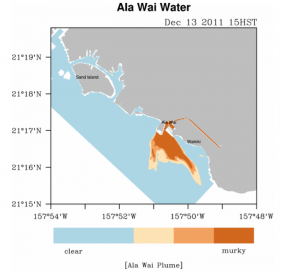By Staff Reports
(Honolulu)– Have you ever wondered if you should go into the water after heavy rains? Or questioned where that brown water goes after it leaves the Ala Wai Canal? Oceanographers working with the Pacific Islands Ocean Observing System (PacIOOS) within the UH Mānoa School of Ocean and Earth Sciences and Technology (SOEST) have focused their work to help address these questions, and they are excited to share the results of their labor: the PacIOOS Ala Wai Turbidity Plume Model.
Turbidity is a measure of water clarity. Tiny solids suspended in the water column can increase turbidity levels. After a significant storm event, “brown water” runoff from the land can raise turbidity levels in coastal waters. “Brown water” or storm water runoff can contain pollutants and contaminants, including sewage, harmful micro-organisms and chemicals from residential, commercial and recreational sources.
Turbidity matters, and knowing where the “brown water” is headed, can help ocean users make more informed decisions. This is the aim of the new PacIOOS model. Available at www.pacioos.org under Water Quality, the PacIOOS Ala Wai Turbidity Plume Model makes water quality data relevant and available to the general public in the form of a map animation. Using near real-time data of river runoff and turbidity for the Ala Wai Canal in a Regional Ocean Modeling System (ROMS) forecast, the map shows the possible path of “brown water” events leaving the Ala Wai Canal.
“The PacIOOS Ala Wai Turbidity Plume Model can help those who recreate in the Ala Moana and Waikīkī areas make more informed decisions about when and where they choose to enter the water, especially after significant rainfall,” Oceanography Professor Margaret McManus explains. “But please remember, the plume position and turbidity values are predictions and — like a weather forecast — contain uncertainties.”
Dr. McManus is one of many to develop this plume model. Other UHM team members include Dr. Brian Powell, Associate Professor of Oceanography; Dr. Eric De Carlo, Oceanography Professor; Dr. Joao Souza, Postdoctoral Researcher of Oceanography; Marcia Hsu, PacIOOS Ocean Scientist/Web Technologist; and Gordon Walker, PacIOOS Oceanographic Research Specialist.
The following link goes directly to the PacIOOS Ala Wai Turbidity Plume Model: http://pacioos.org/focus/modeling/roms_turb.php. For real-time coastal water quality data for Oʻahu, see: http://pacioos.org/focus/waterquality/wq_oahu.php.
About PacIOOS
Based within the School for Ocean and Earth Sciences and Technology at the University of Hawai‘i at Mānoa, PacIOOS is the Pacific Islands regional component of the U.S. Integrated Ocean Observing System (IOOS®). PacIOOS is a partnership of data providers and users working together to enhance ocean observations and develop, disseminate, evaluate, and apply ocean data and information products designed to address the environmental, economic, and public safety needs of stakeholders who call the Pacific Islands home.



